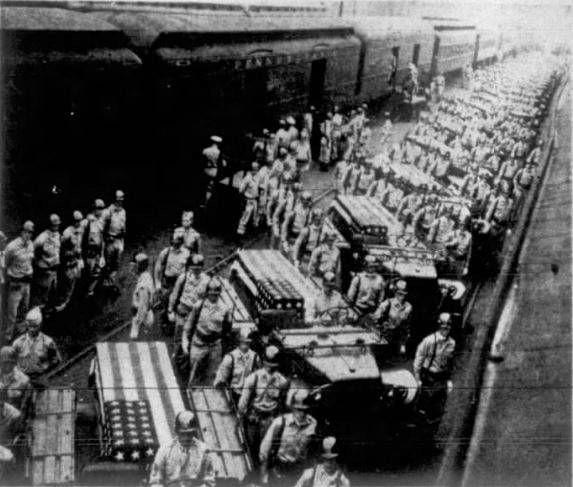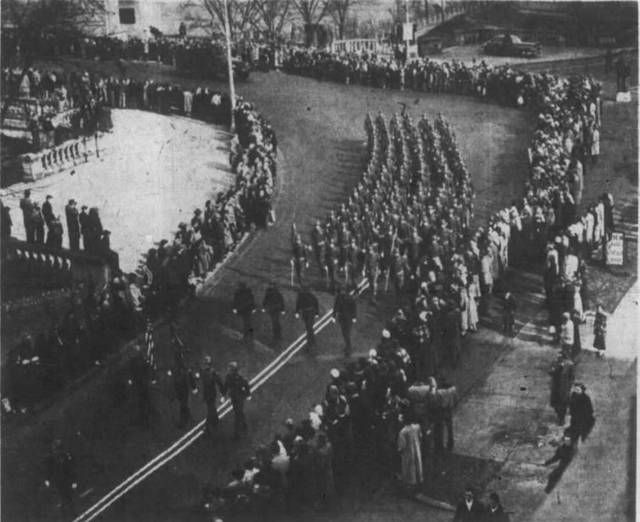Click here to subscribe today or Login.
One of the largest Armistice Day parades in the Wyoming Valley since the end of World War I was held Nov. 11, 1950.
Ten divisions took part in the 1950 parade, the 31st year the parade was held since the end of the Great War.
The parade was dedicated to the 33 soldiers of the 109th Field Artillery Battalion killed a train crash in West Lafayette, Ohio, on Sept. 11, 1950. Nearly 280 soldiers and civilians were injured.
Soldiers from the 109th were on their way to active duty as assigned to the 28th Infantry Guard Division. They were being transported to Camp Atterbury, Indiana, at the time of the train crash.
Lt. Col. Leon W. Beisel, commander of the 967th Field Artillery Battalion and general chairman for the parade, announced Nov. 3, 1950, that the parade would be dedicated to the 33 soldiers.
“Let the people at home pause in their work of peaceful living to rededicate ourselves to the cause of freedom by paying honor to those who gave their lives that we may live in peace,” Beisel told the parade committee as reported in the Evening News newspaper on Nov. 3, 1950.
“Next of kin of Korean casualties and next of kin of the 33 train wreck fatalities were given honored places to view the parade, special bleachers having been provided on Market Street, opposite the West Side Armory,” the Evening News newspaper reported Nov. 11, 1950.
The Evening News reported Nov. 6, 1950, the parade was “expected to be the most mammoth event of its kind in years.”
Nearly every high school in the Wyoming Valley, at the time 20 high schools, took part in the parade with bands, strutters and cheerleaders attired in their school colors.
The parade began at Hoyt Street and Wyoming Avenue in Kingston and marched down Market Street across the Market Street Bridge into Wilkes-Barre.
“The leading contingents had just reached River Street, Wilkes-Barre, at 11 a.m. when the whistles and bells from churches, industrial plants and mine collieries sounded and the marching stopped. All persons parading came to attention as the various musical organizations sounded Taps,” the Evening News reported.
Men doffed their hats and women and children stood silent for a brief interval, and without a doubt, the thoughts of a large majority of those participating and viewing the parade were at that time with the 33 guardsmen of the 109th killed in the Ohio troop train wreck, the newspaper reported.
Military vehicles in the parade included half-tracks, jeeps, scout cars and tank destroyers. The Air Section of the 967th Armored Field Artillery did a fly over and dropped a floral tribute to all comrades who sacrificed their lives for God and country, the Evening News reported.
Despite chilly temperatures in the low 40s, viewers were five to six deep along the parade route. Children sat on their fathers shoulders to watch.
The 109th Field Artillery did not participate in the 1950 parade as they were in federal service.
Ten passenger cars made up the troop train that was stopped on tracks due to a ruptured air-brake hose on the steam locomotive when it was struck from behind by another train that failed to adhere to multiple stop signals and a flagman waving a lantern and flares.
When deceased soldiers returned home on Sept. 14, 1950, more than 200,000 people lined the streets from the Lehigh Valley Railroad Station on East Market Street, Wilkes-Barre, to the armory on Market Street in Kingston, the Wilkes-Barre Record reported Sept. 15, 1950.
A monument outside the armory on Market Street honors those killed in the crash.






